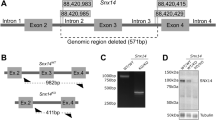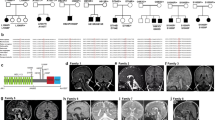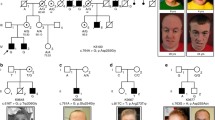Abstract
Deadenylases are best known for degrading the poly(A) tail during mRNA decay. The deadenylase family has expanded throughout evolution and, in mammals, consists of 12 Mg2+-dependent 3′-end RNases with substrate specificity that is mostly unknown1. Pontocerebellar hypoplasia type 7 (PCH7) is a unique recessive syndrome characterized by neurodegeneration and ambiguous genitalia2. We studied 12 human families with PCH7, uncovering biallelic, loss-of-function mutations in TOE1, which encodes an unconventional deadenylase3,4. toe1-morphant zebrafish displayed midbrain and hindbrain degeneration, modeling PCH-like structural defects in vivo. Surprisingly, we found that TOE1 associated with small nuclear RNAs (snRNAs) incompletely processed spliceosomal. These pre-snRNAs contained 3′ genome-encoded tails often followed by post-transcriptionally added adenosines. Human cells with reduced levels of TOE1 accumulated 3′-end-extended pre-snRNAs, and the immunoisolated TOE1 complex was sufficient for 3′-end maturation of snRNAs. Our findings identify the cause of a neurodegenerative syndrome linked to snRNA maturation and uncover a key factor involved in the processing of snRNA 3′ ends.
This is a preview of subscription content, access via your institution
Access options
Access Nature and 54 other Nature Portfolio journals
Get Nature+, our best-value online-access subscription
$29.99 / 30 days
cancel any time
Subscribe to this journal
Receive 12 print issues and online access
$209.00 per year
only $17.42 per issue
Buy this article
- Purchase on Springer Link
- Instant access to full article PDF
Prices may be subject to local taxes which are calculated during checkout






Similar content being viewed by others
References
Goldstrohm, A.C. & Wickens, M. Multifunctional deadenylase complexes diversify mRNA control. Nat. Rev. Mol. Cell Biol. 9, 337–344 (2008).
Anderson, C., Davies, J.H., Lamont, L. & Foulds, N. Early pontocerebellar hypoplasia with vanishing testes: a new syndrome? Am. J. Med. Genet. A. 155A, 667–672 (2011).
De Belle, I., Wu, J.X., Sperandio, S., Mercola, D. & Adamson, E.D. In vivo cloning and characterization of a new growth suppressor protein TOE1 as a direct target gene of Egr1. J. Biol. Chem. 278, 14306–14312 (2003).
Wagner, E., Clement, S.L. & Lykke-Andersen, J. An unconventional human Ccr4–Caf1 deadenylase complex in nuclear cajal bodies. Mol. Cell. Biol. 27, 1686–1695 (2007).
Namavar, Y. et al. Clinical, neuroradiological and genetic findings in pontocerebellar hypoplasia. Brain 134, 143–156 (2011).
Adzhubei, I.A. et al. A method and server for predicting damaging missense mutations. Nat. Methods 7, 248–249 (2010).
Fong, K.W. et al. Whole-genome screening identifies proteins localized to distinct nuclear bodies. J. Cell Biol. 203, 149–164 (2013).
Will, C.L. et al. The human 18S U11/U12 snRNP contains a set of novel proteins not found in the U2-dependent spliceosome. RNA 10, 929–941 (2004).
Nagaraj, N. et al. Deep proteome and transcriptome mapping of a human cancer cell line. Mol. Syst. Biol. 7, 548 (2011).
Baillat, D. et al. Integrator, a multiprotein mediator of small nuclear RNA processing, associates with the C-terminal repeat of RNA polymerase II. Cell 123, 265–276 (2005).
Madore, S.J., Wieben, E.D. & Pederson, T. Intracellular site of U1 small nuclear RNA processing and ribonucleoprotein assembly. J. Cell Biol. 98, 188–192 (1984).
Wieben, E.D., Nenninger, J.M. & Pederson, T. Ribonucleoprotein organization of eukaryotic RNA. XXXII. U2 small nuclear RNA precursors and their accurate 3′ processing in vitro as ribonucleoprotein particles. J. Mol. Biol. 183, 69–78 (1985).
Goldfarb, K.C. & Cech, T.R. 3′ terminal diversity of MRP RNA and other human noncoding RNAs revealed by deep sequencing. BMC Mol. Biol. 14, 23 (2013).
Cho, H.D., Tomita, K., Suzuki, T. & Weiner, A.M. U2 small nuclear RNA is a substrate for the CCA-adding enzyme (tRNA nucleotidyltransferase). J. Biol. Chem. 277, 3447–3455 (2002).
Berndt, H. et al. Maturation of mammalian H/ACA box snoRNAs: PAPD5-dependent adenylation and PARN-dependent trimming. RNA 18, 958–972 (2012).
Lund, E. & Dahlberg, J.E. Cyclic 2′,3′-phosphates and nontemplated nucleotides at the 3′ end of spliceosomal U6 small nuclear RNA's. Science 255, 327–330 (1992).
Granneman, S. & Baserga, S.J. Crosstalk in gene expression: coupling and co-regulation of rDNA transcription, pre-ribosome assembly and pre-rRNA processing. Curr. Opin. Cell Biol. 17, 281–286 (2005).
Phizicky, E.M. & Hopper, A.K. tRNA biology charges to the front. Genes Dev. 24, 1832–1860 (2010).
O'Reilly, D. et al. Differentially expressed, variant U1 snRNAs regulate gene expression in human cells. Genome Res. 23, 281–291 (2013).
Shukla, S. & Parker, R. Quality control of assembly-defective U1 snRNAs by decapping and 5′-to-3′ exonucleolytic digestion. Proc. Natl. Acad. Sci. USA 111, E3277–E3286 (2014).
Izumi, N. et al. Identification and functional analysis of the pre-piRNA 3′ trimmer in silkworms. Cell 164, 962–973 (2016).
Tang, W., Tu, S., Lee, H.C., Weng, Z. & Mello, C.C. The RNase PARN-1 trims piRNA 3′ ends to promote transcriptome surveillance in C. elegans. Cell 164, 974–984 (2016).
Fischer, U., Liu, Q. & Dreyfuss, G. The SMN–SIP1 complex has an essential role in spliceosomal snRNP biogenesis. Cell 90, 1023–1029 (1997).
Liu, Q., Fischer, U., Wang, F. & Dreyfuss, G. The spinal muscular atrophy disease gene product, SMN, and its associated protein SIP1 are in a complex with spliceosomal snRNP proteins. Cell 90, 1013–1021 (1997).
Wan, J. et al. Mutations in the RNA exosome component gene EXOSC3 cause pontocerebellar hypoplasia and spinal motor neuron degeneration. Nat. Genet. 44, 704–708 (2012).
Jia, Y., Mu, J.C. & Ackerman, S.L. Mutation of a U2 snRNA gene causes global disruption of alternative splicing and neurodegeneration. Cell 148, 296–308 (2012).
Schaffer, A.E. et al. CLP1 founder mutation links tRNA splicing and maturation to cerebellar development and neurodegeneration. Cell 157, 651–663 (2014).
Hanada, T. et al. CLP1 links tRNA metabolism to progressive motor-neuron loss. Nature 495, 474–480 (2013).
Budde, B.S. et al. tRNA splicing endonuclease mutations cause pontocerebellar hypoplasia. Nat. Genet. 40, 1113–1118 (2008).
Breuss, M.W. et al. Autosomal-recessive mutations in the tRNA splicing endonuclease subunit TSEN15 cause pontocerebellar hypoplasia and progressive microcephaly. Am. J. Hum. Genet. 99, 228–235 (2016).
Hallais, M. et al. CBC–ARS2 stimulates 3′-end maturation of multiple RNA families and favors cap-proximal processing. Nat. Struct. Mol. Biol. 20, 1358–1366 (2013).
Vance, C. et al. Mutations in FUS, an RNA processing protein, cause familial amyotrophic lateral sclerosis type 6. Science 323, 1208–1211 (2009).
Guthrie, C. & Patterson, B. Spliceosomal snRNAs. Annu. Rev. Genet. 22, 387–419 (1988).
Novarino, G. et al. Exome sequencing links corticospinal motor neuron disease to common neurodegenerative disorders. Science 343, 506–511 (2014).
Chambers, S.M. et al. Highly efficient neural conversion of human ES and iPS cells by dual inhibition of SMAD signaling. Nat. Biotechnol. 27, 275–280 (2009).
Turner, D.L. & Weintraub, H. Expression of achaete-scute homolog 3 in Xenopus embryos converts ectodermal cells to a neural fate. Genes Dev. 8, 1434–1447 (1994).
Van Nostrand, E.L. et al. Robust transcriptome-wide discovery of RNA-binding protein binding sites with enhanced CLIP (eCLIP). Nat. Methods 13, 508–514 (2016).
Akizu, N. et al. Biallelic mutations in SNX14 cause a syndromic form of cerebellar atrophy and lysosome–autophagosome dysfunction. Nat. Genet. 47, 528–534 (2015).
Erickson, S.L. et al. Competition between decapping complex formation and ubiquitin-mediated proteasomal degradation controls human Dcp2 decapping activity. Mol. Cell. Biol. 35, 2144–2153 (2015).
Acknowledgements
We thank the individuals and their families for their contributions to this study. We thank R. Parker (University of Colorado, Boulder) for U1 constructs and F. Tan for his support with protein modeling. We acknowledge M. Gerstein, S. Mane, A.B. Ekici, S. Uebe and the UCSD IGM Genetics Center for sequencing support and analysis, the Yale Biomedical High Performance Computing Center for data analysis and storage, the Yale Program on Neurogenetics and the Yale Center for Human Genetics and Genomics. This study was supported by NIH R01GM077243 and R35GM118069 (to J.L.-A.), NIH R01NS041537, R01NS048453, R01NS052455, P01HD070494, P30NS047101, the Simons Foundation Autism Research Initiative (SFARI) and the Howard Hughes Medical Institute (to J.G.G.), and NIH HG004659 and NS075449 and California Institute of Regenerative Medicine RB3-05009 (to G.W.Y.). G.W.Y. is an Alfred P. Sloan Research Fellow. E.J.B. was supported by a New Scholar award from the Ellison Medical Foundation and a Hellman Fellowship. R.M.L. is the recipient of an NRSA Postdoctoral Fellowship (NIH F32 GM106706) and is a San Diego IRACDA Fellow (NIH K12 GM06852). A.E.S. is a recipient of an A.P. Gianinni Fellowship and an NIH Pathway to Independence Award (K99HD082337). E.L.V.N. is a Merck Fellow of the Damon Runyon Cancer Research Foundation (DRG-2172-13). European Research Council Starting Grant 260888 and the Italian Ministry of Health Ricerca Corrente 2015 supported E.M.V. We thank the Broad Institute (U54HG003067 to E. Lander and UM1HG008900 to D. MacArthur), the University of Washington Center for Mendelian Genomics (UM1HG006493 to M. Bamshad), the Yale Center for Mendelian Disorders (U54HG006504 to R. Lifton and M.G.), and the Gregory M. Kiez and Mehmet Kutman Foundation (to M.G.). W.B.D. was supported by NIH R01NS050375.
Author information
Authors and Affiliations
Contributions
A.E.S., S.M., N.A., A.G.-G., L.D.H. and A.G. performed fibroblast, iPSC, NPC and knockout mouse experiments. R.M.L. generated stable cell lines and performed all snRNA/P experiments. V.R.C.E., N.A., E.S., D. Musaev, R.M., A.W., A.E.S., J.L.S., E.D., R.O.R. and H.T.C. analyzed clinical and exome results. S.G., A.E.S., Z.S., B.R., A.G.-G., I.M.-V. and L.D.H. generated zebrafish data, and N.C.C. and D.T. provided resources for zebrafish experimentation. M.S.Z., N.F., W.B.D., L.S., S.M.B., E.M.V., J.H.D., L.d.M., H.K., U.A., M.L.F., L.W., D.C., S.B., C.F., M.K., K.A.A., D. Manchester, N.M., A.O.Ç., K.B., H.P., M.-C.N., H.S., M.S., K.O. and K.M. conceived of the genetic investigation. S.B.G. and M.G. supported exome sequencing. E.L.V.N., S.S., T.L.S. and G.W.Y. supported RNA sequencing and computational analysis. E.J.B. performed mass spectrometry. R.L.M., A.E.S., J.L.-A. and J.G.G. wrote the manuscript. R.M.L., A.E.S., V.R.C.E., Z.S., N.C.C., D.T., G.W.Y., F.B., J.L.-A. and J.G.G. edited the manuscript. J.L.-A., F.B. and J.G.G. directed the project.
Corresponding authors
Ethics declarations
Competing interests
The authors declare no competing financial interests.
Integrated supplementary information
Supplementary Figure 1 Clinical photos from patients consenting to publish.
(a,b) Affected members of PCH7 families display ambiguous genitalia (a) and exhibit microcephaly, large forehead and mild dysmorphisms (b).
Supplementary Figure 2 Increased homozygosity in consanguineous PCH7 families.
(a) Homozygosity plots showing homozygous blocks (red) in the affected individuals from families 1275 (top) and 1603 (bottom). Arrow, location of TOE1. (b) A 500-kb haplotype block shared by the two affected individuals from families 1275 (left) and 1603 (right) containing the same c.658G>A (p.E220K) TOE1 mutation.
Supplementary Figure 3 TOE1 patient mutations impair TOE1 accumulation.
(a) Human TOE1 and CNOT7 protein alignment showing homology in the de-adenylation domain (DEDD). Inactivating mutations (red), patient mutations (blue). (b) Full-length Western blots corresponding to cropped Western blots in Figure 2c,d. (c) Immunofluorescent images of patient-derived NPCs (1603A) stained for neuronal markers Nestin (green) and Pax6 (red) are indistinguishable from NPCs derived from related (1603U) and unrelated (ATCC) controls. Scale bars, 100 μm. (d) Cropped Western blots for TOE1 following treatment of Flp-In T-REx-293 cells with control siRNA (siCtrl) or siTOE1. (e) Cropped Western blots for FLAG-tagged TOE1 variants produced in stably transfected Flp-In T-REx-293 cells induced with 1 ng/μl tetracycline. The bottom bar graph shows TOE1 mRNA levels monitored by qRT-PCR, normalized for GAPDH mRNA. Level of endogenous TOE1 mRNA was set as 1. Error bars represent s.d. from three independent experiments.
Supplementary Figure 4 TOE1 is widely expressed and required for viability in mice.
(a) RT-PCR (cropped) for TOE1 in various human tissues shows TOE1 is widely expressed. GAPDH is used as a loading control. (b) RT-PCR (cropped) on mouse brains shows that Toe1 is expressed throughout mouse development in both the forebrain and hindbrain. Gapdh is used as a loading control. (c) TOE1 mutant (KO) mice (Toe1-/-) were lethal before embryonic day 11.5 (e11.5). Isolation of embryos from intercrossed Toe1 heterozygous (Het) mice (Toe1+/- x Toe1+/-) produced roughly one-third wild type (WT), two-thirds Toe1 Het, and no Toe1 KO mice at all ages examined (P0, e15.5, and e11.5).
Supplementary Figure 5 Loss of Toe1 in zebrafish induces midbrain and hindbrain apoptosis.
(a) RT-PCR for toe1 in Uninjected, Control MO, toe1 ATG MO, and toe1 Splice-blocking MO injected zebrafish showing efficient intron retention of toe1 in Splice-blocking MO injected fish. nts, nucleotides. (b) Maximum confocal projection of whole mount HuC immunofluorescence in moderately affected toe1 Splice-blocking MO injected zebrafish showing abnormal brain structures. (c) Maximum confocal projection of whole mount zebrafish stained with cleaved caspase-3 (green) and Hoechst (blue) at 24 hpf. The cerebellum and hindbrain of toe1 MO-injected zebrafish show increased cleaved caspase-3-positive cells (quantified at right). Scale bar, 100 μm. Control MO n = 4, toe1 MO n = 6, **P = 0.015.
Supplementary Figure 6 Patient mutation encoding mRNAs cannot rescue gross morphology and structural brain defects in toe1 depleted zebrafish.
(a) Zebrafish at 48 hours post fertilization (hpf) injected with 6 ng toe1 Splice-blocking MO, together with 0.1 pg of human (h) TOE1 mutant mRNAs. MO injected fish with mutant mRNAs (p.F148Y, p.A103T, p.E220K, p.V173G) show abnormal head shape and thin, curved tails. Scale bar, 500 μm. Quantification at bottom right. Normal: no observable phenotype; Moderate: small eyes, slight reduction in head size; Severe: small eyes, small head, thin curved tail. n = 100/condition. (b) Maximum confocal projection of whole mount pan-neuronal HuC immunofluorescence at 48 hpf. Midbrain, cerebellum, and hindbrain regions of toe1 MO zebrafish co-injected with human (h) mutant (p.F148Y, p.A103T, p.E220K, p.V173G) mRNA show little HuC expression. Scale bar, 100 μm. n = 6.
Supplementary Figure 7 TOE1 associates with snRNPs.
Normalized peptide counts from LC/MS-MS assays for anti-FLAG immunoprecipitations from 293-TREx cell lines siRNA-depleted for endogenous TOE1 and stably expressing FLAG only or FLAG-tagged TOE1-WT or -DE at near endogenous TOE1 levels. Normalized peptide counts refer to the number of peptides for individual proteins (PX) per 100 peptides for TOE1 (PTOE1), normalized for amino acid lengths (AA) ((PX/AAX)/(PTOE1/(100*AATOE1))) and subtracted for peptides found in the negative FLAG only control immunoprecipitation. Raw data are listed in Supplementary Table 3.
Supplementary Figure 8 TOE1 targets RNA Pol II snRNAs.
(a) Left: Cumulative plots of sequence reads of U4 and U6 snRNAs depicted as in Figure 4. Only reads terminating at position -4 or after are represented with shaded areas indicating positions within the mature snRNAs. Right: Bar graphs showing the percent of snRNA reads with 3’ tails. Error bars represent s.d., n = 3 independent experiments and p-values (Student’s two-tailed paired t-test) *P < 0.05. (b) Cumulative plots of sequence reads for snRNA 3’ end positions with all reads represented, including those truncated beyond position -4.
Supplementary Figure 9 Position and composition of snRNA unencoded tails.
(a) Bar graphs showing the percent of sequence reads from truncated, mature or 3’ end extended snRNAs that contain untemplated tails as indicated on the snRNA schematic on the left. Gray bar represents the 3’ A and CA nucleotides post-transcriptionally added to RNU2-1 and RNU2-2P snRNAs, respectively, to create their mature 3’ end. Error bars represent s.d., n = 3 independent experiments. (b) Bar graphs: nucleotide compositions of snRNA unencoded tails. Blue: An, oligoadenosine (≥2 A); A, monoadenosine; NA, mixed tail ending with adenosine. Green: Un, oligouridine (≥2 U); U, monouridine; NU, mixed tail ending with uridine. Brown: *G, any tail ending with guanosine. Orange: *C, any tail ending with cytosine. Gray: A and CA as in panel a.
Supplementary Figure 10 TOE1 activity is specific to RNA Pol II snRNAs.
Cumulative plots of 3’ end position of non-coding RNAs: U3 snoRNA, SNORA63 snoRNA, 5.8S rRNA and tRNAs upon treatment with control (siCtrl) or TOE1 siRNA, then induced to express either WT or DE FLAG-TOE1 at near endogenous levels.
Supplementary Figure 11 TOE1 processes the 3’ end of snRNAs to mature length.
(a) Cumulative plot for sequence reads for U2 snRNA 3’ end upon treatment with Mg2+ or EDTA, as in Figure 5b. (b) Levels of U1 variants in 293-TREx cell lines upon treatment with control (siCtrl) or TOE1 siRNA, then induced to express either wildtype (WT) or deadenylase-dead (DE) FLAG-TOE1 at near endogenous levels. Error bars represent s.d., n = 3 independent experiments. (c) Bar graphs showing the ratio of U1 Sm-binding mutants (U1-C2 or U1-C4) to co-transfected WT U1. Transfected U1 variants were internally barcoded to distinguish from endogenous U1 (ref. 20). (d) Cumulative plot of sequence reads for U1-C2 and U1-C4 (left) and respective co-transfected WT U1 3’ end positions.
Supplementary Figure 12 Patient-derived fibroblasts and neuronal progenitor cells (NPCs) show impaired TOE1 accumulation and defects in snRNA 3’ end processing.
(a) Left: Cumulative U5 snRNA 3’ end sequence reads from fibroblast cell lines (top) or patient derived NPCs (bottom) in Figure 6a. Right: Percent reads with gene-encoded 3’ end extensions. (b) Untemplated nucleotide composition analysis for patient fibroblasts as in Supplementary Figure 9b.
Supplementary information
Supplementary Text and Figures
Supplementary Figures 1–12 and Supplementary Tables 2 and 4 (PDF 3302 kb)
Supplementary Table 1
Clinical table of patient features. (XLSX 19 kb)
Supplementary Table 3
LC–MS/MS spectral counts for proteins identified in immunoprecipitations. (XLSX 121 kb)
Supplementary Table 5
DNA and RNA primers. (XLSX 15 kb)
Rights and permissions
About this article
Cite this article
Lardelli, R., Schaffer, A., Eggens, V. et al. Biallelic mutations in the 3′ exonuclease TOE1 cause pontocerebellar hypoplasia and uncover a role in snRNA processing. Nat Genet 49, 457–464 (2017). https://doi.org/10.1038/ng.3762
Received:
Accepted:
Published:
Issue Date:
DOI: https://doi.org/10.1038/ng.3762
This article is cited by
-
Broadening the phenotype and genotype spectrum of novel mutations in pontocerebellar hypoplasia with a comprehensive molecular literature review
BMC Medical Genomics (2024)
-
Role of TOE1 variants at the nuclear localization motif in pontocerebellar hypoplasia 7
Journal of Human Genetics (2024)
-
A non-coding variant in the Kozak sequence of RARS2 strongly decreases protein levels and causes pontocerebellar hypoplasia
BMC Medical Genomics (2023)
-
Assigning functionality to cysteines by base editing of cancer dependency genes
Nature Chemical Biology (2023)
-
Variants in SART3 cause a spliceosomopathy characterised by failure of testis development and neuronal defects
Nature Communications (2023)



